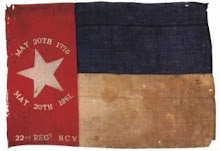As promised I wanted to share some of what I found last week at Canady's Mill on March 12. I created a map to outline what the site looks like today (Jedediah Hotchkiss, I am clearly not!) and also put up a few pictures of the earthworks that remain. In mid-February I went out to the site to do some field research only to find that the area around the earthworks was heavily overgrown. The overgrowth concealed a great portion of the earthworks, but I was able to still see the remains of part of the main fortifications, as well as a line of rifle pits. Luckily, there was a controlled burn on the site last week and almost all of the overgrowth was burned away.
On the morning of February 2, 1864, Company E of the 9th Vermont was on picket duty at Canady's Mill. Company E was under the command of newly promoted Captain Elisha M. Quimby. Quimby replaced Amasa Bartlett, who was promoted to the rank of major after the death of Charles Jarvis. Artillery was also present in support of Company E.
Canady's Mill, along with Company E, would not see any fighting during the Battle of Newport Barracks. Around 11am on February 2, Company E was ordered to return to Newport Barracks after the attack on the Gales Creek Blockhouse. It is unclear the route they took back to Newport, but they appear to have returned after Lieutenant Colonel Barney and the rest of the 9th had moved out to meet Brigadier General Martin and his Confederate forces. Company E would not join the rest of the 9th until after the retreat across the bridges over the Newport River.
The picture below gives an idea of what the site looked like when I visited it in mid-February. It is quite clear the extent of the overgrowth over the earthworks.

From period maps one of the flanks of the fort rested on the Canady Mill Road (Now Roberts Road). You can still see the rough outline of the fort starting from the road, although I am not sure how much of the fort was destroyed during the subsequent widening and paving of the road over the years. The yellow outline in the picture shows the top of the earthworks.

The following is the map I created to give an idea of what the site looks like today.

David Burnette, who accompanied me to the site last week, located what appears to be a small path with rounding on each side, which seems to indicate some level of fortification. This path connected the advance entrenchments and rifle pits to the main fort. It is interesting to note that the path extends a good ways past the earth works and cuts though the fort as diagrammed on the map. The main earthworks at the fort were much more extensive and intricate than previously thought. The main fort is one continuous earthwork that parallels Nine Mile Road before angling back about forty yards and then parallels again with Nine Mile Road. There are still the rough outline of where artillery was placed at the fort, and the advance entrenchments seem to show a fairly strong position. If facing the fort from Nine Mile Road the Newport River is on the left of the position (there is also about a twenty foot drop from the area where the fort is to the river). The pictures that follow show the site on from my visit last week. There is unfortunately little contrast in the pictures, but one can still make out the remains of the fortifications.
The first picture is of the path that David Burnette found on the site. This picture was taken looking towards Nine Mile Road and the path is in the middle of the picture.

The next three pictures are just of the main earthworks at the fort. In the first picture you can see Roberts Road in the background and the earthworks are to the right. The second picture shows more of the works. The lightly colored tree that has fallen is a good marker in this picture, as well as the third.



It was a very productive trip out to the site and the burning that took place really shows the features of the site quite well. Thanks again to David Burnette for emailing me about the burn and accompanying me to the site last Thursday.





No comments:
Post a Comment